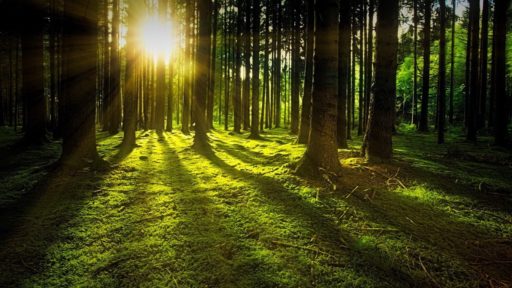I think one of my favorite publications of 2021 was Isabel Fargo Cole’s translation of nineteenth-century Austrian author Adalbert Stifter’s collection of short fiction, Motley Stones. These stories fit into a collection of books I’ve been assembling for over fifteen years, writing I call hypethral. This kind of writing is open to the natural world (the Greek word means open to the skies, exposed to all weathers and seasons, and was originally used to denote a kind of temple). Hypethral writing finds the natural world iconic or sacramental, it reveals nature to be a gateway to that which lies beyond appearance, whether one conceives of that as uncreated light or primordial void or whatever. Another way of putting this is to say that in hypethral writing the sense of place interacts with the sense of the sacred.
In Stifter’s story “Limestone,” the internal narrator—that is, the narrator introduced by the framing device, “Here I shall tell a tale a friend once told us…”—befriends a parson in a remote and barren district, and tells the story of how upon his death the parson made provision for the establishment of a school, so that the children from one village in his parish should not have to travel so far, across an often inhospitable terrain, to go to school. At one point, the narrator sees the children making that commute nearly drowned. Later, he reflects:
Climbing toward the heights of the limestone hills, I thought about the children. How great a thing is inexperience and innocence. Obeying their parents they go where they might find death; for when the Zirder floods the danger is very great, and the children’s ignorance can make it incalculably great. But they know nothing of death. Though its name may cross their lips, they do not know its nature, and their upward-striving life has no perception of extinction. If they themselves slipped into death, they would not know, and would die before they realized it.
Note that the story within a story within a story (sometimes, as in “Limestone,” there are that many layers or more) is one possible analogy, made through the literary form itself, to an ontologically hierarchical cosmos such as the Catholic Stifter perceived. In “Limestone,” the pastor tells the internal narrator his life’s story before he dies, thus revealing something of the motivation behind his desire to help the poor local children in their education. In the end, however, his bequest is inadequate, and no new school can be built. But the local gentry and prominent citizens come together to carry out his wishes anyway, and the internal narrator sees fit to articulate the metaphysical moral of this outcome:
But as evil is always futile in itself, and has no effect in the great scheme of things, whereas good bears fruit, even when begun with inadequate means, so it was here.
The natural world that Stifter beholds and portrays is sublime—let’s remember that the sublime enfolds the notion of holy or transcendent terror. But the natural world so conceived is the material through which Stifter expressed his elemental and traditional religious consciousness, which hinges upon the notion of divine grace. It is through the terrible beauty and danger and wildness of the natural world that Stifter’s God effects his will.
In “Granite,” for example, another internal narrator, a grandfather using the landmarks visible from a high vantage to relate stories to his grandson, describes how a young boy and girl fleeing the plague long ago went into the high hills with their families. Those families perished nonetheless—except for the boy and girl, who found each other and returned to civilization after a somewhat harrowing time in the hills. They later ended up marrying each other, and produced a line of descendants that the grandfather can trace to the present, with relevance to events in the story and helping his grandson make sense of his world. This is a kind of etiological writing, i.e. concerned with origins; it reminds one of the medieval Irish Dindsenchas, or lore of place.
You can see this lore in “Cat-Silver,” which I consider the most haunting story. Three children on a rural estate are in the habit of hiking up into the surrounding hills with their grandmother. They befriend a wild girl there, and eventually she comes to live with them. She saves one of the children when the estate catches fire. But after that she runs off to the forest and mountains again. Such is the arc of the story, not obviously satisfying. It has something of the feeling of a very protracted koan. There are many descriptive passages concerning the turning of the seasons. It need not have been written that way and could easily have been condensed into a single year, even a single summer, if it were really about the mysterious wild girl.
But the story is about the place in the country, of which the wild girl is but one expression. Early in the story, the wild girl saves the children, who are out gathering nuts, from a sudden fierce hailstorm by noticing it coming and quickly building an ingenious shelter out of bundles of sticks. When the children return to their battered home after the storm, the grandmother is questioned why she didn’t watch the clouds and see the storm coming.
“They were watched often,” the grandmother returned, “but when God chooses to perform a visible miracle to rescue little angels, so that we may be edified, all human precautions are vain. In my seventy years I’ve seen all the clouds there are in this land; but if the ones today didn’t look just like the haze that rests blue on all the distant woods in the fall, gleaming white at the edges, descending into the valleys and down upon the land toward evening, but vanishing again by morning and letting the bright sunshine—then let me suffer the harshest punishment here and beyond. And this time of the year there’ve often been thunderstorms. An old proverb says ‘The storms come home on the Nativity of Mary,’ and today it’s six weeks since that holy day. Your old father in his eternal rest will marvel if he learns, or when I come to tell him, that such a great, extraordinary storm came after the Feast of Saint Gall, and that it battered the trees and the houses. It’s a miracle, how God put the thought into the mind of that wild brown child to notice the clouds, and carry up the bundles.”
No one in ordinary conversation is likely to speak so lyrically of landscape, though the sense of grace and the afterlife was once widespread. But as so often happens in fiction (though this is seldom admitted), we are not really being asked to believe in the verisimilitude of the character. We are asked to have something more important: faith in the world of the narrator and the characters—in this case a world of natural disaster that is joined seamlessly through that very nature with the divine. This is our own world for as long as we read, and perhaps for longer.
Jonathan Geltner lives in Ann Arbor MI with his wife and two sons. His translation of Paul Claudel’s Five Great Odes is available from Angelico Press and a novel, Absolute Music, is forthcoming from Slant. If you enjoy his posts at Close Reading, check out his new Substack, Romance and Apocalypse, for more frequent and in-depth essays on the places where literature and other arts meet religious ideas and experience.





